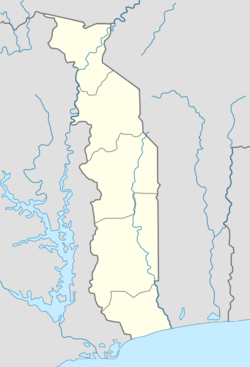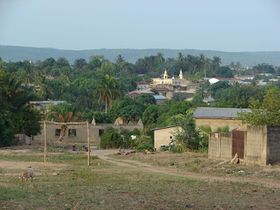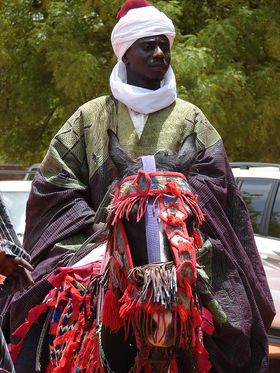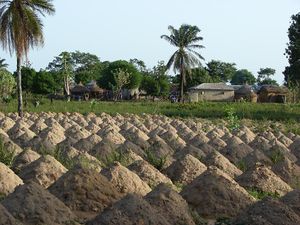سوكوديه
سوكوديه
Sokodé | |
|---|---|
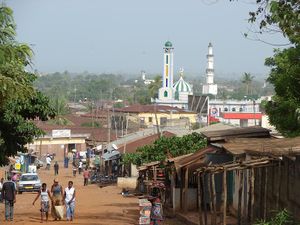 المسجد الجامع في سوكوديه | |
| الإحداثيات: 8°59′N 1°08′E / 8.983°N 1.133°E | |
| البلد | |
| المنطقة | المنطقة الوسطى |
| محافظات توگو | تشاوجو |
| المنسوب | 340 m (1٬120 ft) |
| التعداد (2010) | |
| • الإجمالي | 113٬000 |
سوكوديه Sokodé هي ثاني أكبر مدينة في توگو ومقر تشاوجو والمنطقة الوسطى في وسط البلاد، والتي تبعد 339 كيلومتر شمال لومي. بتعداد 86,500 نسمة (في 2004)، وحالياً نحو 113,000 نسمة، تقع المدينة بين نهري مو و مونو، وهي المركز التجاري للمناطق الزراعية المجاورة. وهي متعددة الأعراق والديانات، ولكن الديانة الغالبة هي الإسلام.
التاريخ
العرق الأصلي القديم في المنطقة اختلط مع المهاجرين الأحدث من الگورما، من الضفة الشرقية لثنية نهر النيجر، بين واگادوگو و نيامي، والذين جلبوا معهم النظام السياسي لزعماء القبائل. كما أضاف لهذا الهيكل التجار والحرفيون السودانيون (الماندنكا، من مالي التاريخية) و الهاوسا، الذين كانوا قوة ديناميكية منذ القرن السادس عشر. وباختيارهم في أواخر عام 1897 أن يؤسسوا ثغراً في سوكوديه، رسخ الألمان دور زعماء قبائل كوتوكولي المهيمنين على المنطقة.
The city developed in precolonial times as a commercial crossroads on the Kola nut route between Ghana and Benin. Currently it is center on the only north-south road in Togo, linking the capital Lomé to Burkina Faso. Urbanization accelerated during colonization. The city consists of older villages that have now become neighborhoods.
Sokodé continues to be governed by a system balanced between a municipal administration and traditional chiefs. Historically, the chiefs of various villages were included in a leadership council, the Tchaoudjo.
الجغرافيا
Sokodé's region is characterized by a dense network of rivers and hilly terrain. The two main rivers are the Kpondjo and Kpandi, which flow into the Na which in turn feeds the Mono River. The border between the Mono and the Volta River drainage basins is located a few kilometers north of the city. It is now in the catchment of the river Mô.
الديمغرافيا
Sokodé is the city with the highest proportion of Muslims in Togo. 70% of the population is Muslim and the remaining 30% are Christians, mostly Catholics. Sokodé is home to the Tem people and most people in Sokodé speak Kotokoli (or tem). The ethnonym Kotokoli is the name that was given to these speakers by traders of the Niger Bend. Many other languages are spoken in Togo, especially ewé, the dominant language of the south, and Kabyé, dominant language of the Kara region, further north. The Kotokoli and Kabyè languages are closely related.
From the standpoint of urban landscape, the city can be divided into two parts: the center, with high density traditional housing, and the suburbs, with housing becoming progressively less adense as one moves away from the center. Modern materials have been increasingly replacing traditional materials (mudbrick).
المناخ والاقتصاد
Situated at an average altitude of 340 m, midway between the ocean and the Sahel strip, Sokodé enjoys a tropical climate, with two distinct seasons: the rainy season, which lasts from April to October, peaking from July to September and the dry season from November to March. The rainfall is between 1،200 و 1،500 mm (47 و 59 in) per year and the number of rainy days varies between 100 and 130. The average temperature is 26 °C (79 °F) (1961–1990). The evaporation rate is high, estimated at 1،500 mm (59 in) / year, and is particularly marked in the harmattan period from November to January. The humidity is very variable, and depends on all the above factors.
Today, the economy Sokodé is dominated by transport, trade and handicrafts. There is little industrial activity. Farmers grow primarily corn, cassava, yams, pepper and beans, and many gardeners and farmers live on the periphery of Sokodé. The farmers are for the most part of the ethnic Fulani[بحاجة لمصدر] (فرنسية: Peuls; فولا: [Fulɓe] Error: {{Lang}}: text has italic markup (help)), many of whom have settled around Sokodé. They have herds of cows in the fields. Meanwhile, nomadic Fulani frequently pass near Sokodé, with their herds of zebu en route between Burkina Faso and Nigeria.
The vegetables are grown especially along the Kpondjo and Inusayo rivers. Most agricultural areas are floodplains, with growers beginning cultivation following the rainy season.
الثقافة
الأعياد
'Gadao-Adossa-Kosso': the main Kotokoli festival consists of three days of festivities, from Friday to Sunday. Celebrated the evening before Adossa, Gadao's function is to thank the ancestors for abundant harvests. Adossa, or the Festival of Knives, is an initiation rite originating with Semassi warriors who demonstrate their strength and courage by undergoing physical challenges. The next day is Kosso, the Festival of Women, in which women dance in the Municipal Park in Sokodé City.
Among others, major festivals are held by different Sokodé clans. In most festivals traditional dancers are invited from the region, as well as riders mimicking the Semassi warriors, spinning at full speed in the middle of the crowd.
الرياضة
The town is home to AC Semassi F.C. who play at the Stade Municipal as do the Tchaoudjo Athlétic Club.
شخصيات هامة


- كوتوكرو - مؤسس سوكوديه.
- ظريفو آييڤا - سياسي
- محمد قادر - footballer
- آدم كودجو - رئيس وزراء توگو الأسبق
- عاصميو توريه - لاعب كرة قدم
- ألفاالحسن - إمام جامع سوكوديه.
